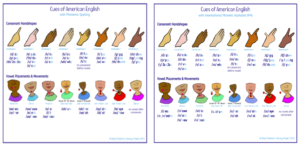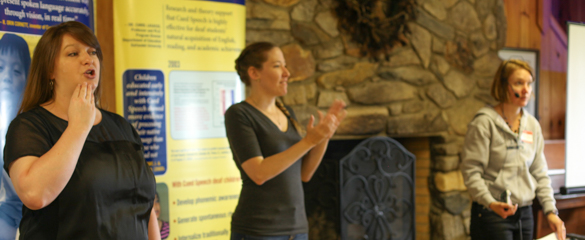Information About Cued Speech
Cued SpeechFAQs About CueingHistory of Cued SpeechResearch Bibliography
 Cued Speech is a visual mode of communication that uses hand shapes and hand placements to show the consonants and vowels of spoken language. Each hand shape represents a group of consonants and each hand placement represents a group of vowels. What looks the same on the mouth must look different on the hand, therefore the hand shapes and hand placements help distinguish between similar-looking speech sounds, or phonemes.
Cued Speech is a visual mode of communication that uses hand shapes and hand placements to show the consonants and vowels of spoken language. Each hand shape represents a group of consonants and each hand placement represents a group of vowels. What looks the same on the mouth must look different on the hand, therefore the hand shapes and hand placements help distinguish between similar-looking speech sounds, or phonemes.
For each phoneme, a handshape and hand placement are combined with the mouth shape to visually show the building blocks of spoken language. An individual can speak and cue at the same time, reinforcing auditory and speech development, while allowing parents and professionals to support language immersion in their native languages. Because Cued Speech is based on the lingusitic properties of spoken language, most individuals are able to learn the system in a few days or less and become expressively fluent at the sentence level within months.

While Director of the Division of Higher Education at the U.S. Office of Education in 1959, Dr. R. Orin Cornett discovered that the typical reading skills of deaf adults were significantly behind their hearing peers. Motivated by this revelation, Dr. Cornett took a position as Vice President of Long-Range Planning at Gallaudet College (now University) with the goal of researching the challenges deaf and hard of hearing children faced in developing literacy skills. During the years 1965 to 1966 Dr. Cornett spent time figuring out how to visualize spoken language and eventually came up with a system of showing spoken language using hand shapes and hand placements. He would call it Cued Speech. Leah Lewis became the first child to acquire language through Cued Speech after her family learned to cue and became accessible language models in the home. Eventually after more parents started learning to cue, a Cued Speech preschool class was established at Gallaudet University in 1972. Seven years later, an additional track for Cued Speech was added to the deaf and hard of hearing programs in the largest public school districts in Virginia and Maryland – Fairfax County Public Schools and Montgomery County Public Schools, respectively. Over the next several decades, multiple cue camps would be established to support families and professionals in learning and practicing Cued Speech. The National Cued Speech Association would formally organize conferences and workshops while the TECUnit would maintain national certification for cued language transliterators in the United States. A significant milestone took place in 2004 when “cued language services” was added to the federal legislation, Individuals with Disabilities Education Act (IDEA). The American with Disabilities Act and Section 504 would follow suit with legislative updates to include Cued Speech as a mode of communication for deaf and hard of hearing individuals. In the past fifty years, Cued Speech has established a presence on six continents and has been adapted to over 60 languages and dialects with active use growing across the globe. Today, Cue College represents the next step in promoting Cued Speech for language and literacy development, speech and auditory skill development, and communication access.

 It takes the average person 10-20 hours of instruction to learn to cue all 40 sounds of English, which would equip them to cue unlimited numbers of words, phrases, and sentences (including nonsense words and proper nouns). It takes another 2-3 weeks to memorize the entire system so that you can cue without a cheat sheet — at a slow but steady speed. It takes another few months of consistent practice to build up your speed to a regular conversational level.
It takes the average person 10-20 hours of instruction to learn to cue all 40 sounds of English, which would equip them to cue unlimited numbers of words, phrases, and sentences (including nonsense words and proper nouns). It takes another 2-3 weeks to memorize the entire system so that you can cue without a cheat sheet — at a slow but steady speed. It takes another few months of consistent practice to build up your speed to a regular conversational level.  Of course! Think of your toolbox. The more options you have, the easier it is to be ready for whatever you need! Cued Speech is compatible with all technology and all other approaches to communicating with and educating a deaf or hard-of-hearing child. This includes using more than one language in a bilingual or multi-lingual approach.Cued Speech can optimize your child’s success with other approaches. Cueing a spoken language helps create an entire phonological model of the language in the mind of the child, preparing him/her to get the most out of hearing aid and/or implant use — and to attain age-appropriate language and literacy skills and overall academic achievement.
Of course! Think of your toolbox. The more options you have, the easier it is to be ready for whatever you need! Cued Speech is compatible with all technology and all other approaches to communicating with and educating a deaf or hard-of-hearing child. This includes using more than one language in a bilingual or multi-lingual approach.Cued Speech can optimize your child’s success with other approaches. Cueing a spoken language helps create an entire phonological model of the language in the mind of the child, preparing him/her to get the most out of hearing aid and/or implant use — and to attain age-appropriate language and literacy skills and overall academic achievement.  Cued American English (CAE) and ASL are visually distinct that children will not get confused by consistent exposure to both modes of communication! There are many different ways that families can provide access to both CAE and ASL in their home. One way would be to have ASL as your child’s first language from you, and CAE as their second language — either at school, from a babysitter, a cueing deaf mentor, or other friends. You can learn along also, but the pressure is off to be the role model for their second language!
Cued American English (CAE) and ASL are visually distinct that children will not get confused by consistent exposure to both modes of communication! There are many different ways that families can provide access to both CAE and ASL in their home. One way would be to have ASL as your child’s first language from you, and CAE as their second language — either at school, from a babysitter, a cueing deaf mentor, or other friends. You can learn along also, but the pressure is off to be the role model for their second language! 
 Cued Speech goes hand in hand with sign languages! There are different ways that families fit both Cued American English and American Sign Language into their home.One way would be to have English (or your preferred language) as your child’s first language through cueing from you, and ASL as their second language—either at school, from a babysitter, a signing deaf mentor, or other friends. You can learn along also, but the pressure is off to be the role model for their second language. Visit
Cued Speech goes hand in hand with sign languages! There are different ways that families fit both Cued American English and American Sign Language into their home.One way would be to have English (or your preferred language) as your child’s first language through cueing from you, and ASL as their second language—either at school, from a babysitter, a signing deaf mentor, or other friends. You can learn along also, but the pressure is off to be the role model for their second language. Visit 
